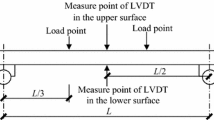Abstract
To gain insight into the physical nature of the coupling between mechanical stress and humidity variations, the behaviour of thin wood strips was studied using specially developed apparatus for creep/recovery and relaxation/blotting-out tests in a controlled humidity environment. The load time and the rate of viscoelastic creep were found to have little influence on mechano-sorptive creep. Moreover, creep trajectory curves for specimens with continuous and interrupted humidity cycles indicated divergence from simple creep-limit behaviour. The effect of transient moisture was also modelled numerically at the molecular level using an idealized cellulose-based composite. Preliminary results suggest that: (i) during free shrinkage, the cellulose chains in elementary fibrils may bend perpendicular to the planes of the hydrogen bonded sheets which form the crystalline lattice; (ii) transient hydrogen bonding between the crystalline cellulose and amorphous polymer owing to the introduction or removal of water may accelerate shear slip between the two phases in the presence of an external load.
Similar content being viewed by others
Author information
Authors and Affiliations
Additional information
Received 6 July 2000
The financial support of the Swiss Federal Office for Education and Science is gratefully acknowledged.
Rights and permissions
About this article
Cite this article
Navi, P., Pittet, V. & Plummer, C. Transient moisture effects on wood creep. Wood Science and Technology 36, 447–462 (2002). https://doi.org/10.1007/s00226-002-0157-1
Issue Date:
DOI: https://doi.org/10.1007/s00226-002-0157-1




